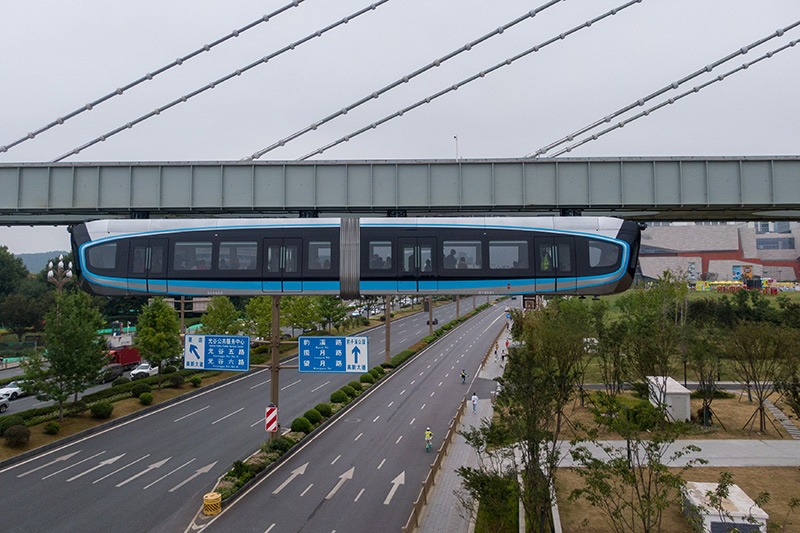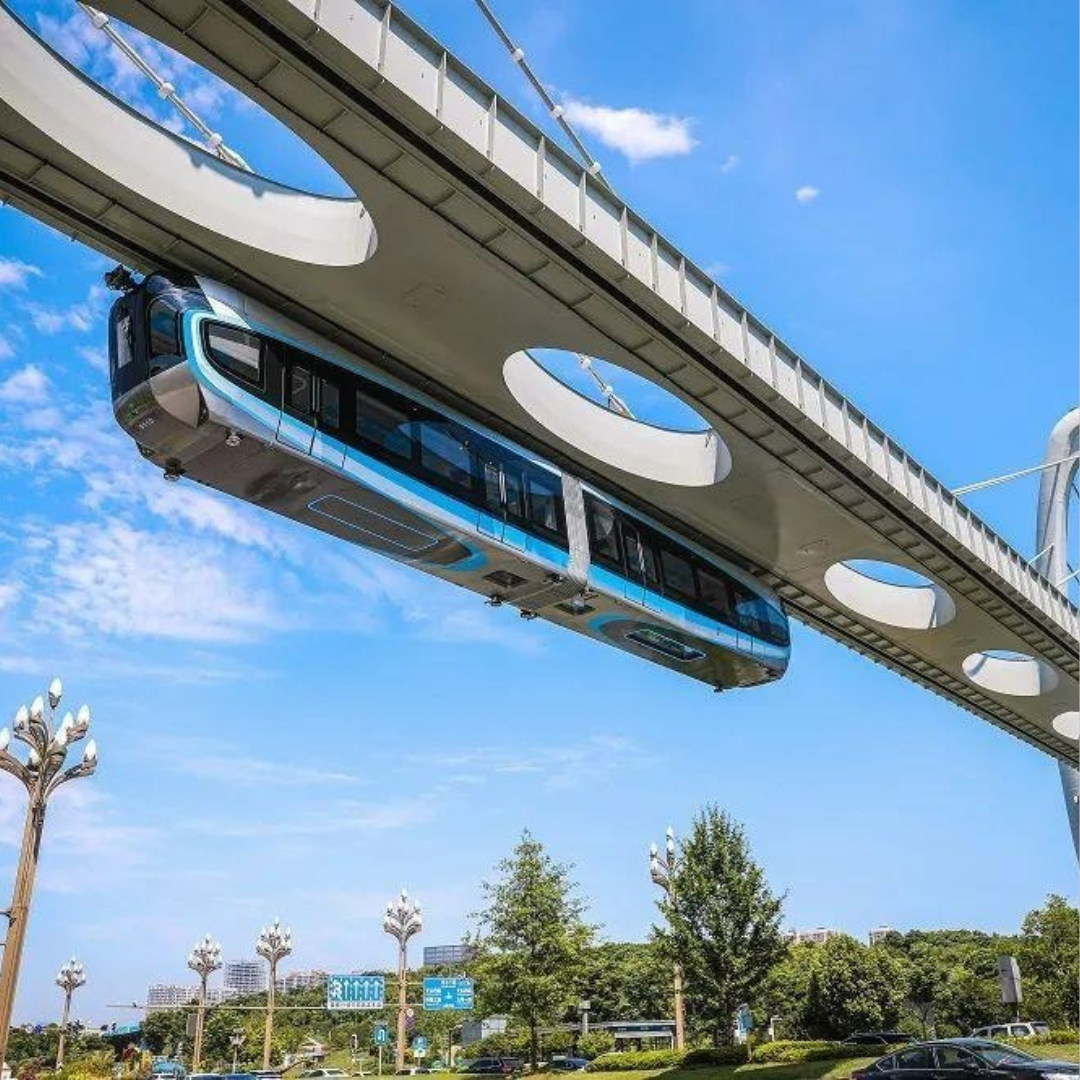China Launches First Suspended Monorail Line
China’s Amazing Inverted Train Experience: Wuhan’s Optics Valley Light Rail
China has once again proven that when it comes to infrastructure and innovation, it’s playing in the future. The latest marvel? The Wuhan Optics Valley Light Rail, popularly known as the Optics Valley Photon, China’s first-ever suspended monorail system. This cutting-edge urban transit experience has captured international attention and is quickly being recognized as a landmark achievement in public transport innovation.
On September 26, 2023, Wuhan became the first city in China to operate a full-scale, commercial suspended monorail. But this isn’t just any monorail. With its futuristic design, driverless operations, and glass-floored cabins, the Optics Valley Light Rail delivers an experience that feels more like a ride at a tech-themed amusement park than everyday public transportation.

What Makes the Optics Valley Light Rail Special?
At first glance, the train’s design is enough to make anyone stop and stare. Unlike traditional trains that run on tracks on the ground, the Optics Valley monorail hangs from the track, which is elevated above the landscape. The train glides beneath this overhead structure, creating an “inverted” appearance—almost like it’s floating through the air.
This suspended configuration offers unobstructed panoramic views of Wuhan’s scenic Optics Valley area. The glass-bottomed carriages give passengers the sensation of gliding through the air, making each trip not just a commute but an experience.
Key Features of the Suspended Monorail
Let’s dive into some of the standout features that set the Optics Valley Photon apart:
🛤️ Route & Coverage
- Route Length: 10.5 kilometers
- Stations: 6 (from Jiufengshan to Longquanshan)
- Operating Hours: 8:00 AM to 8:00 PM
- Frequency: Every 10 minutes
The current line serves both residential and tourist-friendly areas, ensuring it can cater to daily commuters and sightseers alike.
🚄 Technology & Automation
- Driverless Operation: The train is fully automated, with no onboard driver. It is managed through a central AI system that monitors and controls operations in real time.
- Speed: It can travel at up to 60 km/h.
- Capacity: Each train consists of two cars and can accommodate around 220 passengers.
🌍 Design & Sustainability
- Construction Materials: Lightweight aluminum is used for better energy efficiency.
- Power System: Utilizes regenerative braking and energy-saving technology.
- Noise Reduction: The rail system is equipped with shock absorption and noise-reduction systems, making it extremely quiet—a significant benefit in urban areas.
Scenic Route Through a Green Corridor
The train doesn’t just pass through any ordinary part of the city. It travels along an ecological green corridor in the heart of Wuhan’s Optics Valley, connecting technology parks, residential zones, and scenic mountainous areas. From lakes to parks, the route has been carefully selected to make commuting feel like a nature-filled sightseeing tour.
The views from the monorail are nothing short of breathtaking. Whether you’re gliding past treetops or observing bustling city squares below, the journey is immersive and visually rewarding. It’s not surprising that social media is filled with videos of thrilled passengers documenting their first ride aboard this inverted wonder.

Global Significance & Comparisons
China may be entering the game now, but suspended monorails have been operational in other parts of the world for decades. Notable examples include:
- Wuppertal Schwebebahn in Germany – Operational since 1901
- Chiba Urban Monorail and Shonan Monorail in Japan
- Skytrain in Düsseldorf, Germany
However, China’s Optics Valley Photon is the first of its kind in the country and is being hailed as one of the most advanced in terms of automation, safety, and design.
What distinguishes Wuhan’s system is its dual focus on high-tech urban mobility and tourism-enhancing design. It’s not just about getting from point A to B—it’s about making that journey memorable.
Urban Planning Meets Future Transit
The introduction of the Optics Valley suspended monorail marks a significant shift in how China is approaching urban transport. The system offers several advantages over traditional rail or road transport:
- Minimal land use: Since it’s suspended, it doesn’t consume valuable ground-level space.
- Eco-friendly design: Promotes green urban development.
- Congestion reduction: It bypasses traffic and road intersections entirely.
- Scalability: It can be expanded easily to cover more parts of the city without disrupting existing infrastructure.
The line is part of a broader development strategy aimed at making Wuhan—and specifically Optics Valley—a hub for smart city technology and sustainable urban living.
Future Plans: Expansion in the Pipeline
The project is just getting started. According to Chinese government sources, Phase 2 of the Optics Valley Light Rail is already in planning and is expected to:
- Extend the line to 26.7 km
- Add up to 16 stations
- Connect more districts across Wuhan, improving regional connectivity and accessibility
With such expansion, Wuhan could soon become the model city for next-generation monorail systems, not just in China, but globally.
Public Reception & First Impressions
The response from the public has been overwhelmingly positive. Passengers have praised:
- The smoothness of the ride
- The aesthetic appeal of the cabins
- The futuristic vibe of gliding through the sky
- The comfort and cleanliness inside the cabins
Videos of the train in motion—especially shots from the glass-bottomed cabins—have gone viral on platforms like TikTok and Weibo, bringing attention from not only across China but the entire world.

A Bold Leap Toward Smart Urban Mobility
China’s launch of the Wuhan Optics Valley suspended monorail underscores the nation’s commitment to futuristic and sustainable transportation. It demonstrates how cities can blend technology, design, and practicality to offer public transit that excites as much as it serves.
By embracing such innovative transportation models, cities like Wuhan are paving the way for a smarter, cleaner, and more enjoyable urban experience. Whether you’re a daily commuter, a technology enthusiast, or a global traveler, the Optics Valley Photon is worth keeping an eye on—and perhaps, one day, riding yourself.
China recently unveiled the Optics Valley Suspended Monorail (nicknamed “Optics Valley Photon”)—a driverless, inverted train system in Wuhan’s Optics Valley—on September 26, 2023. Passengers ride in gondolas suspended from a track overhead, offering a thrilling perspective complete with glass floors for panoramic city views
🛤️ Key Features & Specs
- Length & Coverage: 10.5 km with six stations from Jiufengshan to Longquanshan
- Driverless Innovation: Fully automated operation, no onboard drivers, and trains scheduled every ten minutes between 8 am–8 pm
- Speed & Capacity: Trips reach up to 60 km/h, carrying approximately 220 passengers across two-car trains.
- Sustainable Design: Uses lightweight aluminum construction, energy-regeneration tech, and shock-absorbers for comfort .
🌿 Dual Purpose: Commuter & Tourist Delight
Designed to serve both daily commuters and sightseeing enthusiasts, the monorail runs along a broad ecological corridor that links urban high-tech districts with scenic mountains, parks, and lakes. Local riders praised the breathtaking views and futuristic feel, making it a sought-after experience.
🌍 Global Context
This isn’t Wuhan’s first—suspended monorails exist in Germany and Japan—but it represents China’s first commercial implementation. It joins global counterparts in Wuppertal, Düsseldorf, Chiba, and Shonan.
🎯 Why It Matters
- Urban Innovation: It provides efficient transit, minimizes land use, and bypasses surface congestion.
- Tourism & Economy: Enhances city appeal, fosters innovation, and supports sustainable urban growth.
- Future Expansion: Phase two will extend to 26.7 km with 16 stations, further improving connectivity.
In Conclusion
China’s Wuhan Optics Valley Light Rail isn’t just another transportation project. It’s a symbol of what modern urban mobility can look like—efficient, eco-friendly, and visually stunning. As more cities around the world grapple with congestion, pollution, and aging infrastructure, Wuhan’s suspended monorail stands tall (or rather, hangs high) as a beacon of what’s possible.







Leave feedback about this
You must be logged in to post a comment.